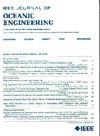Generation Mechanism of Acoustic Doppler Velocity Measurement Bias
IF 3.8
2区 工程技术
Q1 ENGINEERING, CIVIL
引用次数: 0
Abstract
A Doppler velocimetry logger (DVL) is a sonar attached to a vehicle that, when underway, transmits a pulse signal at regular intervals and measures the Doppler frequency of the seafloor echo to determine the vehicle's velocity relative to the Earth. The velocity measurement bias of DVL refers to the deviation of the average measurement velocity from the true value and is a quantitative measure of accuracy, which can be used to evaluate the performance of a DVL. DVL designers must tradeoff velocity measurement bias and requirements, such as size and power. To date, the DVL measurement bias has received little attention, and the underlying physical mechanism has yet to be completely elucidated. In this article, the DVL echo is modeled by a linear time-varying channel. An analytical expression for the DVL seafloor echo Doppler spectrum is established by analyzing echo statistical properties. The physical mechanism of the bias has been analyzed by this analytical expression. Then, an analytical equation for predicting the bias is proposed. Compared with the bias prediction method proposed by Taudien and Bilén (2018), the equation proposed in this article has equivalent predictive power, but with clear physical meaning, and provides a means to predict bias.声波多普勒测速偏差的产生机理
多普勒测速记录仪(DVL)是一种附着在船只上的声纳,当船只航行时,它会定期发送脉冲信号,并测量海底回波的多普勒频率,以确定船只相对于地球的速度。DVL测速偏差是指DVL平均测速与真实测速的偏差,是一种精度的定量度量,可以用来评价DVL的性能。DVL设计人员必须权衡速度测量偏差和要求,例如尺寸和功率。迄今为止,DVL测量偏差很少受到关注,其潜在的物理机制尚未完全阐明。本文采用线性时变信道对DVL回波进行建模。通过对回波统计特性的分析,建立了DVL海底回波多普勒频谱的解析表达式。用此解析式分析了偏置的物理机理。然后,提出了预测偏差的解析方程。与Taudien和bil(2018)提出的偏倚预测方法相比,本文提出的方程具有同等的预测能力,但具有明确的物理意义,为偏倚预测提供了一种手段。
本文章由计算机程序翻译,如有差异,请以英文原文为准。
求助全文
约1分钟内获得全文
求助全文
来源期刊

IEEE Journal of Oceanic Engineering
工程技术-工程:大洋
CiteScore
9.60
自引率
12.20%
发文量
86
审稿时长
12 months
期刊介绍:
The IEEE Journal of Oceanic Engineering (ISSN 0364-9059) is the online-only quarterly publication of the IEEE Oceanic Engineering Society (IEEE OES). The scope of the Journal is the field of interest of the IEEE OES, which encompasses all aspects of science, engineering, and technology that address research, development, and operations pertaining to all bodies of water. This includes the creation of new capabilities and technologies from concept design through prototypes, testing, and operational systems to sense, explore, understand, develop, use, and responsibly manage natural resources.
 求助内容:
求助内容: 应助结果提醒方式:
应助结果提醒方式:


